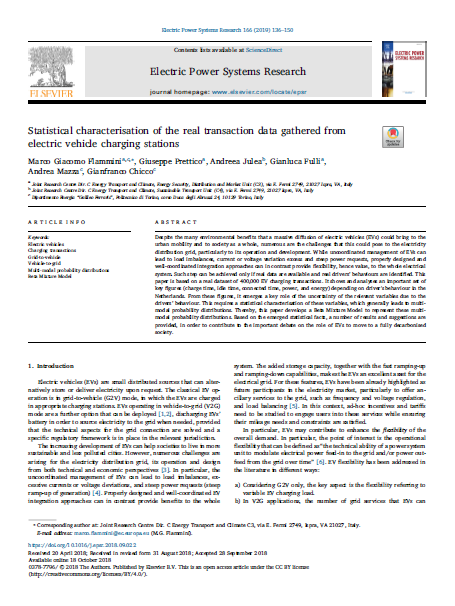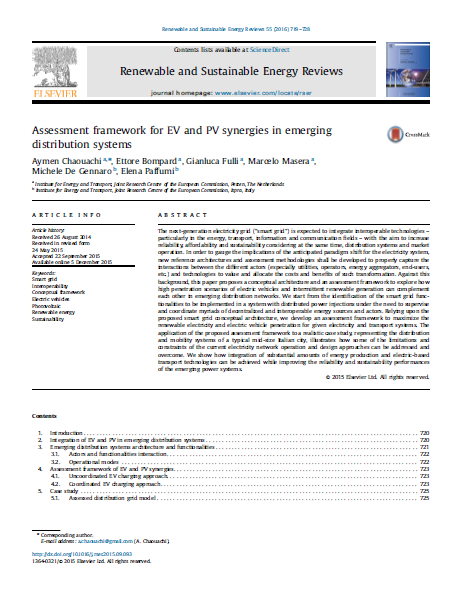Background and context
Interoperability aims at ensuring the interwork and the data exchanges between the e-mobility and the smart grid systems. Interoperability will thus not only facilitate reliable communication and functionality of any plug-in vehicle with recharging devices – it will rather pave the way for seamless integration of e-mobility into tomorrow's smart grid infrastructure.
Our role
We look into interoperability issues between the electric vehicles and the charging infrastructure, covering hardware and information exchange protocols. In particular, we assess EV fast charging devices' performances in different conditions and scenarios. Exposing electric vehicles to extreme temperatures limits their driving and charging performances. For the foreseen adoption of EVs not only it is important to study the technology behind it, but also the environment it will be inserted in. In Europe, temperatures ranging from -30 °C to +40 °C are frequently observed and the impacts on batteries are well known. However, the impact on the grid due to the performance of fast chargers under such conditions also requires analysis, as it affects both on the infrastructure’s dimensioning and design.
Main publications

2019 - Distribution Network Model Platform: A First Case Study
Decarbonisation policies have recently seen an uncontrolled increase in local electricity production from renewable energy sources (RES) at distribution level. As a consequence, bidirectional power flows might cause high voltage/ medium voltage (HV/MV) transformers to overload. Additionally, not-well-planned installation of electric vehicle (EV) charging stations could provoke voltage deviations and cables overloading during peak times. To ensure secure and reliable distribution network operations, technology integration requires careful analysis which is based on realistic distribution grid models (DGM). Currently, however, only not geo-referenced synthetic grids are available in literature. This fact unfortunately represents a big limitation. In order to overcome this knowledge gap, we developed a distribution network model (DiNeMo) web-platform aiming at reproducing the DGM of a given area of interest. DiNeMo is based on metrics and indicators collected from 99 unbundled distribution system operators (DSOs) in Europe. In this work we firstly perform a validation exercise on two DGMs of the city of Varaždin in Croatia. To this aim, a set of indicators from the DGMs and from the real networks are compared. The DGMs are later used for a power flow analysis which focuses on voltage fluctuations, line losses, and lines loading considering different levels of EV charging stations penetration.

2019 - Statistical characterisation of the real transaction data gathered from electric vehicle charging stations
Despite the many environmental benefits that a massive diffusion of electric vehicles (EVs) could bring to the urban mobility and to society as a whole, numerous are the challenges that this could pose to the electricity distribution grid, particularly to its operation and development. While uncoordinated management of EVs can lead to load imbalances, current or voltage variation excess and steep power requests, properly designed and well-coordinated integration approaches can in contrast provide flexibility, hence value, to the whole electrical system. Such step can be achieved only if real data are available and real drivers’ behaviours are identified. This paper is based on a real dataset of 400,000 EV charging transactions. It shows and analyses an important set of key figures (charge time, idle time, connected time, power, and energy) depending on driver's behaviour in the Netherlands. From these figures, it emerges a key role of the uncertainty of the relevant variables due to the drivers’ behaviour. This requires a statistical characterisation of these variables, which generally leads to multimodal probability distributions. Thereby, this paper develops a Beta Mixture Model to represent these multimodal probability distributions. Based on the emerged statistical facts, a number of results and suggestions are provided, in order to contribute to the important debate on the role of EVs to move to a fully decarbonised society.

2018 - Indicator-Based Methodology for Assessing EV Charging Infrastructure Using Exploratory Data Analysis
Electric vehicle (EV) charging infrastructure rollout i swell underway in several power systems, namely North America, Japan, Europe, and China. In order to support EV charging infrastructures design and operation, little attempt has been made to develop indicator-based methods characterising such networks across different regions. This study defines an assessment methodology, composed by eight indicators, allowing a comparison among EV public charging infrastructures. The proposed indicators capture the following: energy demand from EVs, energy use intensity, charger’s intensity distribution, the use time ratios, energy use ratios, the nearest neighbour distance between chargers and availability, the total service ratio, and the carbon intensity as an environmental impact indicator. We apply the methodology to a dataset from ElaadNL, a reference smart charging provider in The Netherlands, using open source geographic information system and R software. The dataset reveals higher energy intensity in six urban areas and that 50% of energy supplied comes from 19.6% of chargers. Correlations of spatial density are strong and nearest neighbouring distances range from 1101 to 9462 m. Use time and energy use ratios are 11.21% and 3.56%. The average carbon intensity is 4.44 gCO2eq/MJ. Finally, the indicators are used to assess the impact of relevant public policies on the EV charging infrastructure use and roll-out.

2016 - Assessment framework for EV and PV synergies in emerging distribution systems
This paper proposes a conceptual architecture and an assessment framework to explore how high penetration scenarios of electric vehicles and intermittent renewable generation can complement each other in emerging distribution networks. We start from the identification of the smart grid functionalities to be implemented in a system with distributed power injections under the need to supervise and coordinate myriads of decentralized and interoperable energy sources and actors. Relying upon the proposed smart grid conceptual architecture, we develop an assessment framework to maximize the renewable electricity and electric vehicle penetration for given electricity and transport systems. The application of the proposed assessment framework to a realistic case study, representing the distribution and mobility systems of a typical mid-size Italian city, illustrates how some of the limitations and constraints of the current electricity network operation and design approaches can be addressed and overcome. We show how integration of substantial amounts of energy production and electric-based transport technologies can be achieved while improving the reliability and sustainability performances of the emerging power systems.
